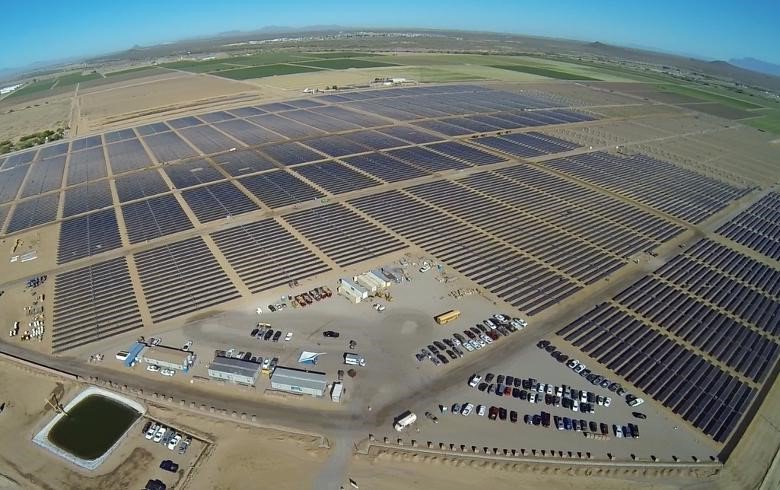Arizona’s Salt River Project (SRP) has an election coming up—and solar power proponents are pushing for change.
The Salt River Project, a public utility in Arizona, was founded during the Roosevelt Dam’s construction process 115 years ago. This dam was backed by the land titles of Phoenix-area residents, which has affected how SRP has done business.
Today, that means 10 of the 14 seats on the board, which votes on water and electricity matters affecting millions of people, are chosen by landowners in direct proportion to the amount of land they own. The final four seats are voted on by land owners, as well—but voters from these districts are given one vote per person, regardless of land volume. These final four at-large seats are considered more open to shifts.
And shifts seem possible, but distant, as the politics surrounding solar power in the sun-soaked state have reached a pitch recently.
Just two weeks ago, SRP and Tesla settled a lawsuit. The lawsuit alleged the utility was acting like a monopoly and unfairly charging solar power generators. When the charges were initially discussed, thousands of protesters showed up. The pending settlement has Tesla dropping charges in exchange for SRP buying a big battery but no retraction of the monopolistic rate. A great summary of the suit was put out yesterday on Twitter:
Three years ago, SolarCity sued SRP about its charges for rooftop solar. Today, the parties are before the #SCOTUS but the case is not about solar or the charges. https://t.co/Qlx6ppyyDk (initial complaint)
— Ari Peskoe (@AriPeskoe) March 19, 2018
This local-level intrigue is complemented by state-level complexities as well. While we have seen the FBI looking into Arizona Corporation Commission elections and whether or not certain electricity utilities have been improperly financing campaigns with customer money, we’ve also got Arizona state regulators pushing back against these same utilities by voting against their fossil-fuel-powered energy plans and requesting 80% clean energy.
Three of the five pro-solar individuals running for office are running in acreage-based districts,
- Sheila Motomatsu for District 10. Electrical engineer by trade, with experience at the U.S. Department of Energy at Sandia National Laboratories.
- Jeffrey Grout for District 8. Energy engineer focused on efficiency projects for large businesses.
- Dennis Burke for District 6. Writer and researcher, fourth-generation Arizonian whose grandfather worked on the Roosevelt Dam.
And the two in the at-large districts,
- Corey Hawkey, who works on sustainability practices at Arizona State University.
- Randy Miller, a software engineer. He bought a new house within SRP land so he could legally run for office.
AZCentral suggests that while the open seats are more probable to shift—see what happened in 2016 election—incumbents seem able to hold strongly onto their seats.
Financial Advisor Wendy Marshall holds the seat Randy Miller is running for. Marshall was quoted by AZCentral as saying, “I think solar is a terrific thing—we have added a lot, and will continue to add it—but until battery storage is financially feasible, we need to do it in measured steps.”
With SRP’s recent agreement to purchase the 25 MW battery storage plant from Tesla and an agreement at an Arizona utility to buy solar+storage at 4.5¢/kWh, might Marshall soon turn into a solar power proponent?
The nuance of these ongoing shifts at Phoenix-area SRP, complementing the nuance of clean energy mandates fighting it out at the state’s public utilities commission, seem a perfect microcosm of the globe’s broader ongoing energy transition efforts. Definite efforts and successes as we move forward—but through layers and layers of complexity.
This content is protected by copyright and may not be reused. If you want to cooperate with us and would like to reuse some of our content, please contact: editors@pv-magazine.com.








I didn’t know SRP picked Tesla. They are the best in the World.
Quote=With SRP’s recent agreement to purchase the 25 MW battery storage plant from Tesla and an agreement at an Arizona utility to buy solar+storage at 4.5¢/kWh, might Marshall soon turn into a solar power proponent?